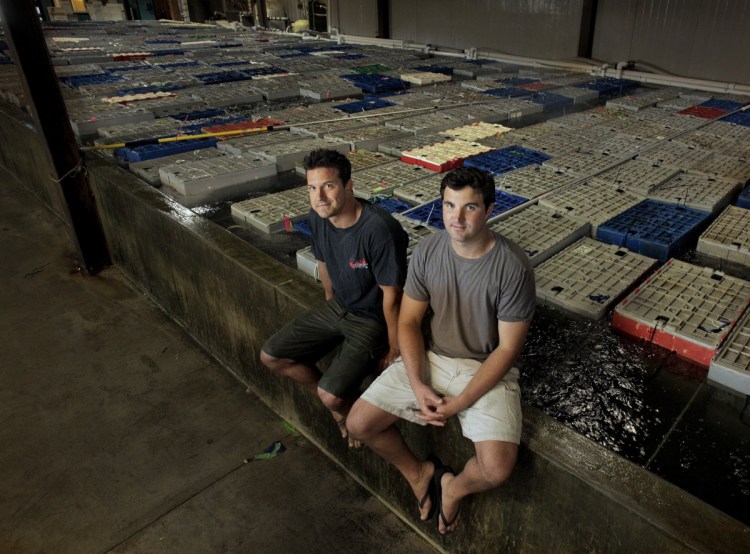A new lobster processing facility planned for 40 acres on Route 1 in Saco represents a significant addition to the state’s limited processing operations.
The facility received a necessary zoning change from Saco municipal officials Monday night, allowing the plan by Ready Seafood Co. to go forward.
The company already has processing facilities in Scarborough and a holding facility in Portland. Last fall it announced plans to partner with the University of Maine in a research project to see if they can discover and test safe methods to toughen the shells of soft-shell lobsters, which would allow the crustaceans to be shipped greater distances for distribution.
Although Maine leads the country in lobster landings, a large percentage of its catch has to be sent to Canada for processing, where dozens of companies turn millions of pounds of lobster into tails, knuckle meat and claws that end up in lobster rolls or frozen pot pies.
“We feel it is the right thing to do for the industry, which certainly needs more processing infrastructure,” John Ready, co-founder of the company, said of the Saco expansion. “We are here for the next generation and dedicated to allowing lobstermen and women to continue to fish along the Maine coast successfully and economically. That means more value needs to be created.”
In 2017, Maine exported $215 million worth of wholesale lobster to Canada, most of it for processing. As Maine expands its processing capacity, more of the value added to the raw lobster landed in Maine – $435 million in 2017 – can remain in Maine, said Annie Tselikis, director of the Maine Lobster Dealers Association.
In a typical year, 30 percent to 40 percent of lobsters landed in Maine end up in Canada for processing, Tselikis said. That’s because Maine only has six large processing facilities, while the Canadian Maritimes is home to four times as many, with more capacity on the way.
“Any growth in processing capacity here at home is a good thing,” Tselikis said. “When we send our lobster to Canada to get processed, we lose our country of origin. It becomes a product of Canada. We want our lobster to remain just that: a signature product of Maine.”
‘FIND WAYS TO MAXIMIZE THE RESOURCE’
Trucking the lobster to Canada also increases transportation costs, which raises the final cost of the value-added product to the consumer, she said. Keeping the price of lobster affordable helps keep demand high for what is still a luxury product, she said.
Lobster processing is relatively new in Maine, growing from practically nothing 25 years ago to 15 facilities in 2013, although some of those are small and do not focus exclusively on lobster. In 2014, as lobster landings began to soar, Maine voters approved spending $7 million to build up Maine’s processing capacity,
Now Maine has six large lobster processing facilities – one in eastern Maine and five in the Portland region, Tselikis said. Although Tselikis is unfamiliar with the details of the project, she said Ready’s Saco plant would likely grow that number to seven.
Last year, Shucks Lobster of Richmond got a local planning permit to build a 28,000-square-foot processing facility in a Gotham industrial park that would employ up to 80 people during the peak season.
But it isn’t easy. In 2016, Sea Hags Seafood closed its seafood processing plant in St. George after just four years of operation. Although speaking generally, and not about Sea Hags, Tselikis said it can be difficult for a new company to compete in the volatile seafood market. The seasonal nature of the Maine lobster cycle also poses labor challenges, she said.
But Ready prides itself on finding ways to capitalize on razor-thin margins. It has been keen to find innovative ways to add value to its product to overcome trade barriers, logistical challenges and declining catches, going so far as to hire a lobster biologist and fund public lobster research.
“We must prepare for leaner years and find ways to maximize the resource,” Brendan Ready said last year when talking about efforts to harden soft-shell lobsters enough to survive shipping to Europe.
39.8-ACRE PARCEL SOLD FOR $675,000
The Ready plant will be built on the northwest side of Route 1, down the road from the Saco Drive-In. The 39.8-acre lot, which has one house on it but was advertised for commercial or industrial development, sold to 1016 Portland Road LLC in October for $675,000, according to county land records.
The Saco City Council voted Monday to allow food processing facilities, something the city has traditionally considered light industry, in multi-use and industrial districts like the one at 1016 Route 1, which paved the way for Ready Seafood to announce its plans. The town’s economic development director, William Mann, requested the zoning change in January, saying at the time that the company’s investment and job creation will be “very significant.”
Saco already is home to a lobster processor. Cape Seafood opened its plant in December 2012 to process the lobster used to supply Luke’s Lobster restaurants. Run by Luke and Bryan Holden, that plant creates up to 125 local jobs during the peak season.
Penelope Overton can be contacted at 791-6463 or at:
poverton@pressherald.com
Twitter: PLOvertonPPH
Send questions/comments to the editors.


